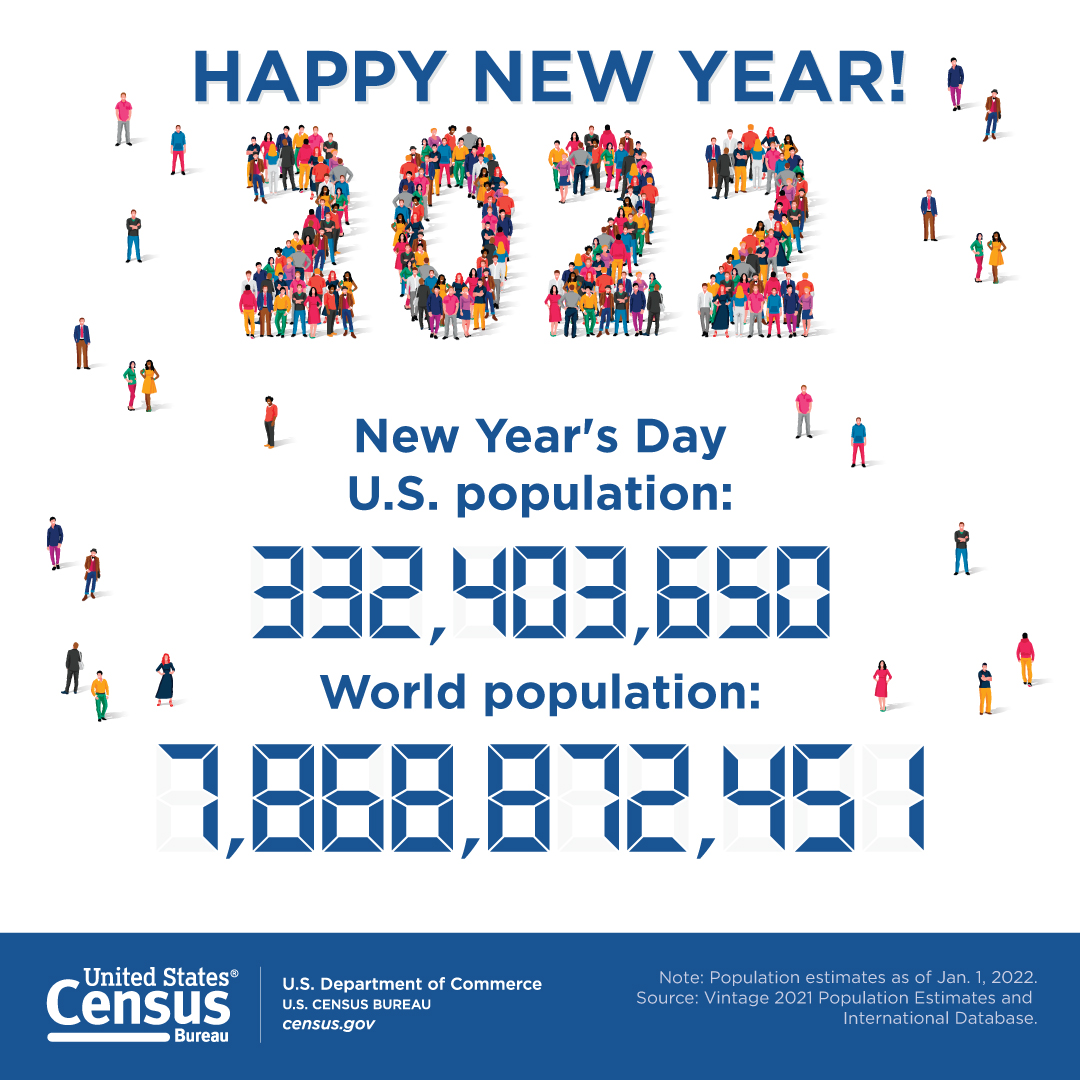U.S. Population Estimated at 332,403,650 on Jan. 1, 2022
As our nation prepares to ring in the new year, the U.S. Census Bureau projects the United States population will be 332,403,650 on Jan. 1, 2022.
This represents a 0.21% increase in population or an additional 706,899 people since New Year’s Day 2021.
The combination of births, deaths and net international migration increases the U.S. population by one person every 40 seconds.
Population increased 0.29% since Census Day, April 1, 2020, adding 954,369 people during that period.
In January 2022, the United States is expected to experience a birth every nine seconds and one death every 11 seconds. Meanwhile, net international migration is expected to add one person to the U.S. population every 130 seconds.
The combination of births, deaths and net international migration increases the U.S. population by one person every 40 seconds.
The projected world population on Jan. 1, 2022 is 7,868,872,451, an increase of 74,235,487, or 0.95%, from New Year’s Day 2021.
During January 2022, 4.3 births and 2.0 deaths are expected worldwide every second.
Population Estimates From the U.S. and World Population Clock
The Census Bureau’s Population Clock displays simulated real-time growth of the U.S. and world populations.
The U.S. clock shows the population by age (0 to 100+) and sex, and the most populous and highest density states, counties, and cities. The world clock shows the most populous countries, as well as the top U.S. export and import partners.
Image is linked to the current Population Clock estimates.
Population Projections From the International Database
Created in the 1960s, the Census Bureau’s International Database (IDB) now produces projections for 227 countries and areas with populations of 5,000 or more. Population size (by single year of age and sex) and components of change (fertility, mortality and migration) are available for each calendar year through 2100 (through 2060 for the U.S.).
In 2025, the IDB Trends (chart below) shows India passing China in total population (around 1.42 billion each) to become the world’s most populous country.
The United States will still be the third most populous nation with about 344 million people. However, Nigeria is projected to pass it and move into third place in the 2040s.
Image is linked to the International Database (IDB).
The IDB is an interactive data tool that provides data for countries and areas in the Country Dashboard.
There are tables for several reports, including Demographic Overview, Components of Population Growth, Fertility, Mortality, Migration. Users can also create custom reports on specific areas of interest.
The dashboard also includes tabs on other topics: The Map tab measures population, fertility, mortality and migration; the Population by Age tab shows age pyramids and tables; and the Trends by country shows population, annual growth rate and other measures from 1950 to 2100 (2060 for the U.S.).
Derick Moore is a senior communications specialist in the Census Bureau’s Communications Directorate.
Related Statistics
-
Stats for StoriesWorld Population Day: July 11, 2024The U.S. Census Bureau’s International Database estimates the world population will reach 9 billion in 2037.
-
Stats for StoriesAmerican Housing Month: June 2023The 2021 American Community Survey counted 142.15M housing units, up 3.61M from 2018, and up 10.36M from 131.79M in 2010.
Subscribe
Our email newsletter is sent out on the day we publish a story. Get an alert directly in your inbox to read, share and blog about our newest stories.
Contact our Public Information Office for media inquiries or interviews.
-
America Counts StoryPopulation Grew 0.1% in 2021, Slowest Rate Since America’s FoundingDecember 21, 2021With the exception of the last few years, the U.S. population has not grown at such a slow rate since 1918, during the influenza pandemic and World War I.
-
America Counts StoryAdult Population Grew Faster Than Total Population From 2010 to 2020August 12, 2021The first detailed results of the 2020 Census released today show a nationwide shift in the age makeup of the U.S. population from 2010 to 2020.
-
America Counts StoryMore Than Half of U.S. Counties Were Smaller in 2020 Than in 2010August 12, 2021The U.S. Census Bureau today released the first 2020 Census population counts for counties, metropolitan and micropolitan statistical areas, and cities.
-
Business and EconomyWhat Is the Nonemployer Marine Economy?April 09, 2025Thirty states had nonemployer businesses in marine economy sectors, including six states in the Midwest with receipts totaling nearly $11 billion in 2022.
-
Business and EconomyEconomic Census Geographic Area Statistics Data Now AvailableApril 07, 2025A new data visualization based on the 2022 Economic Census shows the changing business landscape of 19 economic sectors across the United States.
-
Income and PovertyWhat Sources of Income Do People Rely On?April 02, 2025A new interactive data tool shows income sources for hundreds of demographic and economic characteristic combinations.
-
Business and EconomyBig Improvements to the Annual Integrated Economic Survey (AIES)March 26, 2025The Census Bureau is making several changes and enhancements to capture 2024 economic data based on feedback from last year’s survey.









